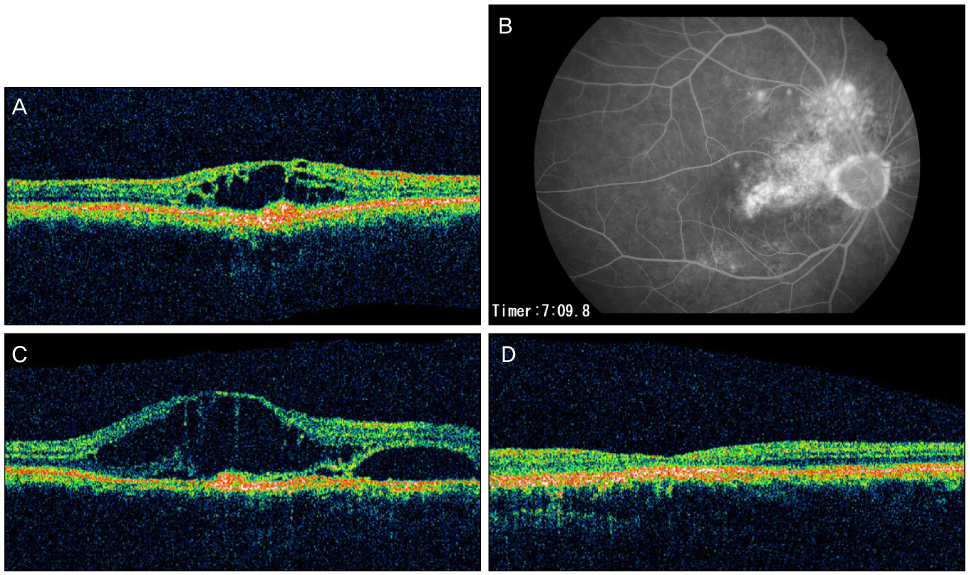J Korean Ophthalmol Soc.
2012 Mar;53(3):428-433.
Effect of Intravitreal Injection as a Primary Treatment in Cystoid Macular Edema after Cataract Surgery
- Affiliations
-
- 1Myung-Gok Eye Research Institute, Kim's Eye Hospital, Konyang University College of Medicine, Seoul, Korea. yjlew@kimeye.com
- 2Seoul Bright Eye Clinic, Seoul, Korea.
- 3Department of Ophthalmology, Konyang University Hospital, Daejeon, Korea.
Abstract
- PURPOSE
To report the clinical manifestations of intravitreal triamcinolone injection as a primary treatment method for patients with cystoid macular edema after cataract surgery.
METHODS
The present retrospective study was comprised of patients diagnosed with cystoid macular edema after cataract surgery performed between March 2006 and March 2008. To treat the edema, intravitreal triamcinolone injection was administered. Best corrected visual acuity (BCVA) and central macular thickness were measured, and complications as well as efficacy of the treatment were evaluated.
RESULTS
Twelve eyes were selected for the present study with a mean patient age of 67.3 years. The average period between cataract surgery and diagnosis of cystoid macular edema was 7.6 weeks. All 12 eyes received an intravitreal triamcinolone injection, and the patients were followed up for an average of 6.7 months. BCVA (log MAR) was changed from 0.29 +/- 0.12 to 0.11 +/- 0.09, showing statistically significant improvement (p = 0.000). The OCT showed that the average CMT was statistically decreased from 390.58 +/- 94.98 microm to 165.17 +/- 39.95 microm (p = 0.001). No complications were reported after the procedure, and vision and edema improved after one month in all 12 eyes.
CONCLUSIONS
After performing intravitreal triamcinolone injection as a primary treatment method for cystoid macular edema which developed after cataract surgery, rapid recovery and improvement of vision and macular thickness were confirmed in all 12 eyes.
Keyword
MeSH Terms
Figure
Reference
-
1. Gass JD, Norton EW. Cystoid macular edema and papilledema following cataract extraction. A fluorescein funduscopic and angiographic study. 1966. Arch Ophthalmol. 1966. 76:646–661.2. Jaffe NS. Cataract Surgery and Its Complications. 1984. 4th ed. St. Louis: Mosby;426–441.3. Kim JC, Lim DG. Cystoid macular edema in pseudophakia. J Korean Ophthalmol Soc. 1990. 31:1148–1151.4. Drolsum L, Haaskjold E. Causes of decreased visual acuity after cataract extraction. J Cataract Refract Surg. 1995. 21:59–63.5. Flach AJ. The incidence, pathogenesis, and treatment of cystoid macular edema following cataract surgery. Trans Am Ophthalmol Soc. 1998. 96:557–634.6. Levin DS, Lim JI. Update on pseudophakic cystoid macular edema treatment options. Ophthalmol Clin North Am. 2002. 15:467–472.7. Stark WJ Jr, Maumenee AE, Fagadau W, et al. Cystoid macular edema in pseudophakia. Surv Ophthalmol. 1984. 28:Suppl. 442–451.8. Arevalo JF, Maia M, Garcia-Amaris RA, et al. Intravitreal bevacizumab for refractory pseudophakic cystoid macular edema: the Pan-American Collaborative Retina Study Group Results. Ophthalmology. 2009. 116:1481–1487.9. Flach AJ. The incidence, pathogenesis and treatment of cystoid macular edema following cataract surgery. Trans Am Ophthalmol Soc. 1998. 96:557–634.10. Miyake K, Ibaraki N. Prostaglandins and cystoid macular edema. Surv Ophthalmol. 2002. 47:Suppl 1. S203–S218.11. Flach AJ, Dolan BJ, Irvine AR. Effectiveness of ketorolac tromethamine 0.5% ophthalmic solution for chronic aphakic and pseudophakic cystoid macular edema. Am J Ophthalmol. 1987. 103:479–486.12. Flach AJ, Jampol LM, Weinberg D, et al. Improvement in visual acuity in chronic aphakic and pseudophakic cystoid macular edema after treatment with topical 0.5% ketorolac tromethamine. Am J Ophthalmol. 1991. 112:514–519.13. Shulman S, Ferencz JR, Gilady G, et al. Prognostic factors for visual acuity improvement after intravitreal triamcinolone injection. Eye (Lond). 2007. 21:1067–1070.14. Koutsandrea C, Moschos MM, Brouzas D, et al. Intraocular triancinolone acetonide for pseudophakic cystoids macular edema: optical coherence tomography and multifocal electroretinography study. Retina. 2007. 27:159–164.15. Karacorlu M, Ozdemir H, Karacorlu S. Intravitreal triamcinolone acetonide for the treatment of chronic pseudophakic cystoid macular oedema. Acta Ophthalmol Scand. 2003. 81:648–652.16. Negi AK, Vernon SA, Lim CS, Owen-Armstrong K. Intravitreal triamcinolone improves vision in eyes with chronic diabetic macular oedema refractory to laser photocoagulation. Eye (Lond). 2005. 19:747–751.17. Noma H, Minamoto A, Funatsu H, et al. Intravitreal levels of vascular endothelial growth factor and interleukin-6 are correlated with macular edema in branch retinal vein occlusion. Graefes Arch Clin Exp Ophthalmol. 2006. 244:309–315.18. Mason JO 3rd, Albert MA Jr, Vail R. Intravitreal bevacizumab (Avastin) for refractory pseudophakic cystoid macular edema. Retina. 2006. 26:356–357.19. Barone A, Prascina F, Russo V, et al. Successful treatment of pseudophakic cystoid macular edema with intravitreal bevacizumab. J Cataract Refract Surg. 2008. 34:1210–1212.
- Full Text Links
- Actions
-
Cited
- CITED
-
- Close
- Share
- Similar articles
-
- The Effect of Intravitreal Triamcinolone Acetonide Injection according to the Diabetic Macular Edema Type
- The Effects of Intravitreal Bevacizumab Injection According to the Type of Diabetic Macular Edema
- The Results of a Combination of Cataract Surgery and Intravitreal Bevacizumab Injection for Diabetic Macular Edema
- A Case of Repeated Intravitreal Dexamethasone Implantation for Treatment of Macular Edema after Scleral Fixation of Intraocular Lens
- Intravitreal Injection of Triamcinolone Acetonide on Refractory Uveitis



